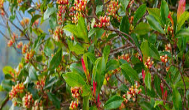Effect of Ginger (Zingiber officinale), Cinnamon (Cinnamomum verum), Cloves (Syzygium aromaticum), and their Combination on Blood Glucose, Superoxide Dismutase, and Malondialdehyde Levels in Diabetic Rat
Main Article Content
Abstract
Diabetes mellitus is characterized by high blood glucose levels known as hyperglycemia. In addition, diabetes is associated with decreased Superoxide Dismutase and increased Malondialdehyde levels. Alternative treatments for diabetes mellitus may involve the use of natural ingredients. This study aimed to evaluate the effect of Ginger (Zingiber officinale), Cinnamon (Cinnamomum verum), Cloves (Syzygium aromaticum), and their combination on blood glucose, superoxide dismutase (SOD) and malondialdehyde (MDA)levels in a rat model of diabetes mellitus. Diabetes was induced in the rats by a single intraperitoneal dose of streptozotocin (55 mg/kg BW). The diabetic rats were divided into five groups; DM which served as the control (Diabetic rats without treatment), A1 (Diabetic rats treated with Zingiber officinale extract), A2 (Diabetic rats treated with Cinnamomum verum extract), A3 (Diabetic rats treated with Syzygium aromaticum extract), and A4 (Diabetic rats treated with a combination of the three spices). The treatments were orally administered once daily for 14 days. On day 15, all the rats were euthanized, and blood samples were collected. The blood samples were analyzed for the concentrations of glucose, superoxide dismutase (SOD), and malondialdehyde (MDA). The results showed that the administration of A3 significantly reduced blood glucose level, the administration of A1 and A4 significantly reduced MDA level compared to the control. Therefore, these spices have the potential to be used as an alternative medicine for the treatment of diabetes mellitus.
Downloads
Article Details

This work is licensed under a Creative Commons Attribution-NonCommercial-NoDerivatives 4.0 International License.
References
Lestari ND, Rahmah AC, Adharini WI, Nilamsari RV, Jatmiko YD, Widodo N, Rahayu S, Rifa’i M. Bioactivity of Moringa oleifera and albumin formulation in controlling TNF-α and LFN-γ production by NK cells ⅰn mice model type 1 diabetes. Jordan J Biol Sci. 2022; 15(2):205-208.
Adharini WI, Nilamsari RV, Lestari ND, Widodo N, Rifa'i M. Immunomodulatory effects of formulation of Channa micropeltes and Moringa oleifera through anti-inflammatory cytokines regulation in type 1 diabetic mice. Pharm Sci. 2020; 26(3):270-278.
World Health Organization (WHO). Diabetes fact and number. Geneva: WHO Press; 2016.
IDF. Facts & figures. [Online]. 2021 [cited 2023 Jan 23]. Available from: https://idf.org/about-diabetes/diabetes-facts-figures/.
Ministry of Health Republic Indonesia. Diabetes melitus is our problem. [Online]. 2022 [cited 2023 Nov 23]. Available from: https://yankes.kemkes.go.id/view_artikel/1131/.
Kartini S, Bakar MF, Bakar FI, Endrini S, Hendrika Y, Juariah S. Antioxidant Properties of Curcuma caesia Extracted Using Natural Deep Eutectic Solvent. Trop J Nat Prod Res. 2023; 7(12):5479-5485.
Kowluru A. Oxidative stress in cytokine-induced dysfunction of the pancreatic beta cell: Known knowns and known unknowns. Metabol. 2020; 10(12):480.
Asmat U, Abad K, Ismail K. Diabetes mellitus and oxidative stress—a concise review. Saudi Pharm J. 2016; 24(5):547-553.
Morales M and Munné-Bosch S. Malondialdehyde: Facts and artifacts. Plant Physiol. 2019; 180(3):1246-1250.
Mostafavinia A, Amini A, Ghorishi SK, Pouriran R, Bayat M. The effects of dosage and the routes of administrations of streptozotocin and alloxan on induction rate of type l diabetes mellitus and mortality rate in rats. Lab Anim Res. 2016; 32(3):160-165.
Abdelli W and Hamed D. Molecular Docking and Pharmacokinetics Studies of Syzygium aromaticum Compounds as Potential SARS-CoV-2 Main Protease Inhibitors. Trop J NatProd Res. 2023; 7(11):5155-5163.
Johnson BS, Adeola BA, Abudulkareem OT. Efficacy of Prepubertal Administration of Zingiber officinale (Ginger) on Reproductive Hormones in Male Sprague-Dawley Rats. Trop J Nat Prod Res. 2023; 7(12):5710-5714.
Qar J, Al-Trad B, Muhaidat R, Omari S, Al-Omari G. The Effect of Eugenol Treatment on Diabetic Cardiomyopathy in Streptozotocin-Induced Diabetic Rats. Biomed Pharmacol J. 2022; 15(5):623-633.
Quyen PT and Quoc L. Chemical Profile and Biological Activities of The Essential Oil of Cinnamon (Cinnamomum cassia (L.) J. Presl) Twigs and Leaves. Trop J Nat Prod Res. 2023; 7(11):5226-5230.
Mollazadeh H and Hosseinzadeh H. Cinnamon effects on metabolic syndrome: A review based on its mechanisms. Iran J Basic Med Sci. 2016; 19(12):1258-1270.
Steven S, Frenis K, Oelze M, Kalinovic S, Kuntic M, Bayo Jimenez MT, Vujacic-Mirski K, Helmstädter J, Kröller-Schön S, Münzel T, Daiber A. Vascular inflammation and oxidative stress: Major triggers for cardiovascular disease. Oxid Med Cell Longev. 2019; 2019:e7092151.
Irahal IN, Guenaou I, Lahlou FA, Hmimid F, Bourhim N. Syzygium aromaticum bud (clove) essential oil is a novel and safe aldose reductase inhibitor: In silico, in vitro, and in vivo evidence. Hormones. 2022; 21(2):229-240.
Abtahi-Eivari SH, Shokoohi M, Ghorbani M, Halimi M, Hajizadeh H, Pourlak T, Bahrami J, Ghoreishi Z. Effects of Hydroalcoholic Extracts of Cloves (Syzygium aromaticum) on the Serum Biomarkers, Antioxidant Status, and Histopathological Changes of Kidneys in Diabetic Rats. Cresc J Med Biol Sci. 2021; 8(4):269–275.
Meulmeester FL, Luo J, Martens LG, Mills K, van Heemst D, Noordam R. Antioxidant supplementation in oxidative stress-related diseases: What have we learned from studies on alpha-tocopherol?. Antioxidants. 2022;11(12):2322.
Qiao Y, Zhao J, Li C, Zhang M, Wei L, Zhang X, Kurskaya O, Bi H, Gao T. Effect of combined chronic predictable and unpredictable stress on depression-like symptoms in mice. Ann Transl Med. 2020; 8(15):942.


